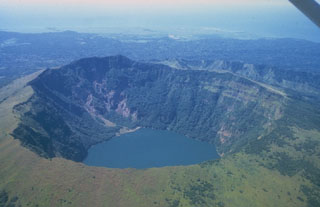Report on Cosiguina (Nicaragua) — April 2003
Bulletin of the Global Volcanism Network, vol. 28, no. 4 (April 2003)
Managing Editor: Edward Venzke.
Cosiguina (Nicaragua) Earthquake swarm in September 2002
Please cite this report as:
Global Volcanism Program, 2003. Report on Cosiguina (Nicaragua) (Venzke, E., ed.). Bulletin of the Global Volcanism Network, 28:4. Smithsonian Institution. https://doi.org/10.5479/si.GVP.BGVN200304-344010
Cosiguina
Nicaragua
12.98°N, 87.57°W; summit elev. 872 m
All times are local (unless otherwise noted)
In September 2002 an earthquake swarm was registered near Cosigüina. This swarm was the first to be recognized at that volcano in the 27 years of the existence of Nicaragua's seismic network. The historical seismic record contains no evidence of the type of cluster that occurred in September 2002, although there was seismic activity in 1951 that could have been of local origin (see below).
The seismicity began on 4 September, with M 2.4-3.6 events. The main earthquake occurred on 9 September with a magnitude of 3.9. The last event occurred on 16 September with a magnitude of 3.7. A total of 34 earthquakes occurred to the N of Cosigüina volcano. Unfortunately, the seismic station at the volcano failed to function due to radio signal transmission problems. Seismic readings were also obtained from the National System of Territorial Studies of El Salvador (SNET) for 31 earthquakes. Epicenters of the earthquakes, located with the readings obtained by the seismic networks of the Instituto Nicaragüense de Estudios Territoriales (INETER) and SNET, were concentrated in a zone approximately 4-5 km N and W of the crater (figure 1). The distribution, along a SW-NE axis, might be simply a product of the geometry of the configuration of seismic stations with which the events were located.
 |
Figure 1. Epicentral map of the earthquakes located N of Cosigüina volcano. September 2002. Black triangle indicates approximate summit location. Courtesy of INETER. |
Randy White (USGS) indicated to INETER that the seismicity seems to have been of the volcano-tectonic type, caused by an intrusion of magma, based on several observations: 1) the two stages of the cluster on 4-6 and 9 September showed a release of similar seismic energy; 2) In the two stages there were many similarly sized events; 17 with a magnitude of 3.0 or less, but none greater than 3.9; 3) The maximum magnitude increased several times; and 4) The distribution of energy was highly unusual for tectonic seismicity. Apparently there were several groups of one or a few events in intervals of 5-7 hours. Regular pulsations are typical for volcanic earthquake swarms that last more than several hours.
INETER volcanologist Pedro Perez investigated the volcano on 12 September, but saw nothing anomalous. He also conducted interviews with local residents, went to the summit crater, and took measurements of thermal waters at the foot of the volcano. Within the crater walls, landslides were observed in the E, S, and W portions. Residents in the Marañonal, Potosí, Punta Ñata, and Apascali sectors did not feel the earthquakes.
Seismicity in August 1951. The following description is based on news reports compiled by INETER (The News, 1951 Ago. 07; The Press, 1951 Ago. 04, 05, 07, 09, 18).
In August 1951 there was strong seismic activity in western Nicaragua and southwestern Honduras. On 2 August one of a series of strong events produced a 200-m-long crack near Cosigüina that spewed large amounts of water, flooding the region. The seismic shocks also demolished three houses in Chinandega. These earthquakes were felt more strongly to the W and diminished to the N and in the direction of Managua. The population in these areas slept outside their homes for many days. The people of these sectors, mainly the western population, felt continuous and violent seismic shocks until 8 August. On 17 August a strong tremor shook the western region and Managua. Apparently, this seismic activity produced more than 100 events, not all of which were felt by all residents.
Geological Summary. Cosigüina (also spelled Cosegüina) is a low basaltic-to-andesitic composite volcano that is isolated from other eruptive centers in the Nicaraguan volcanic chain. The stratovolcano forms a large peninsula extending into the Gulf of Fonseca at the western tip of the country. It has a pronounced somma rim on the northern side; a young summit cone rises 300 m above the northern somma rim and buries the rim on other sides. The younger cone is truncated by a large elliptical prehistorical summit caldera, 2 x 2.4 km in diameter and 500 m deep, with a lake at its bottom. Lava flows predominate in the caldera walls, although lahar and pyroclastic-flow deposits surround the volcano. A brief but powerful explosive eruption in 1835 is Nicaragua's largest during historical time. Ash fell as far away as México, Costa Rica, and Jamaica, and pyroclastic flows reached the Gulf of Fonseca.
Information Contacts: Virginia Tenorio and Wilfried Strauch, Instituto Nicaragüense de Estudios Territoriales (INETER), Apartado 1761, Managua, Nicaragua (URL: http://www.ineter.gob.ni/).

